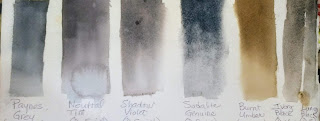Grisailles is, basically, using a gray, like Paynes Gray or Neutral Tint, something fairly STAINING, to create an underpainting first, sculpting the forms and creating values before laying on any color. Then, you glaze over with color.
BEFORE STARTING, SELECT AN APPROPRIATE PAINT AND PAPER.
CHOOSING A PAINT:
Your underpainting needs to have three characteristics:
#1: transparency
#2: staining - a 4 on a scale of 0-4
#3: Large Value range (at least 62 out of 100)
Transparency speaks for itself: you don't want an opaque color that will dull the painting. Oddly, most of these dark colors are transparent or semi.
Staining:
You want a STAINING paint that will not move or dull your color. I can suggest several useful colors: Neutral Tint, Paynes Gray, Indigo mixed with a bit of orange, burnt umber, Vandyke Brown. If you don't have these, try Prussian Blue with a bit of strong orange or burnt sienna. NOT ALL BRANDS are created equal, so you will need to test your mix. Here's how:
*Paint strips of several paints you think might work.Dry completely.
*Try lifting with a stiff brush. Or soak the strips for a few minutes and see which ones lift or smudge.
Here below are the colors I tried: Paynes Gray (Senelier); Neutral Tine (Daniel Smith); Shadow Violet (Daniel Smith); Sodalite Genuine (D. Smith); Burnt Umber (Holbein); Ivory Black (DaVinci); and Lunar Black (d. Smith) I could have also tried Sepia and other blacks. I included some that granulate in case I decided to do a piece with lots of texture.
This is the same chart as above with each one swiped through with a lifting brush, as seen on the top of each color. From this I could see that some of my faves lifted too easily to be used in a grisaille. I picked some random colors to paint over to see how each would look glazed with colors.
Verdict: I will probably stick with Neutral Tint or Paynes Gray...maybe Burnt Umber if it is a warmer painting. If I want some texture, probably some Lunar Black. Love Sodalite, but it lifted far more than I expected.
In the picture below, note that on the side I have included the pigment codes for the colors. I also showed different colors glazed over the grays and browns.
Value Range: This is how many values from light to dark on the value scale your colors will go. For example, they might rate a yellow as a 10; a red about a 40 or 50; a blue about a 60. The scale goes from 0 to 100. You need your dark to be able to go from very light to very dark, so it would be 60 or above.
Some grays are warmer, some cooler. This will be guided by a personal preference and the overall tone of the painting.
Lindsay Weirich, The Frugal Crafter, has an excellent youtube video on a simple grisaille using QoR Neutral Tint.
CHOOSING PAPER:
You will be fine if you usually use something like Arches hot or cold press. Both of these have about the right amount of sizing. You do not want a paper that is overly sized and lifts and resists glazing techniques. (like Strathmore and some Canson) Some watercolor boards work well also. Please test the color on the paper you wish to use to be sure that the underpainting color (the gray) will not lift and smudge.
OTHER OPTIONS IN GRISAILLE:
Your underpainting can be done with an Inktense colored pencil, (by Derwent) which will not lift after you wet it the first time. There are also graphite pencils that are made to be wet. Some people use India ink for a very dramatic effect.
If you use a brown underpainting, it is called BRUNAILLES.
A green underpainting is VERDAILLES.
Gray is GRISAILLES.
MIDTONES are when you make your own gray from the colors in your painting, as we did with the lilies and the white roses. These are often chosen because there is more unity in your painting. They are usually not as staining as other options, which can be a good thing, depending on your desired outcome.
















